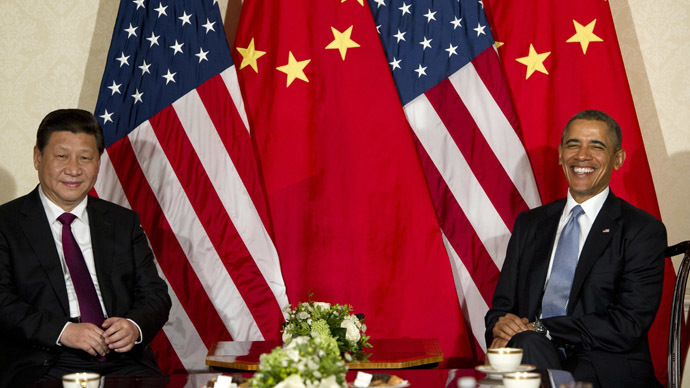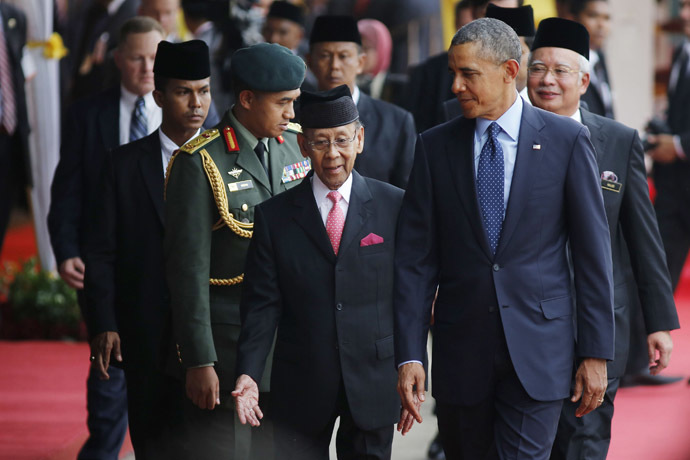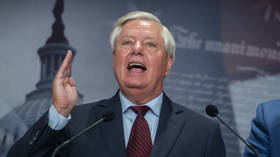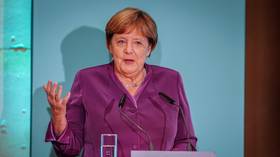Obama makes South China waves

Pivoting and pivoting like a widening gyroscope, to paraphrase Yeats, US President Barack Obama’s current tour of Northeast and Southeast Asia hides an invisible dragon in the cockpit: China.
It’s all about China, whose “trade bullying” and “military belligerence” a benign US empire swears to protect its Asian allies from.
After eating hopefully non-Fukushima radiated sushi in Tokyo with nationalists/militarist Prime Minister Shinzo Abe, Obama – quite undiplomatically – took no time to favor Japan over the serious Senkaku/Diayou islands dispute, referring to a dodgy security treaty which allows the US to aid Japan in case of a foreign attack.
The Chinese Foreign Ministry’s response was swift – identifying the treaty as “a product of the Cold War era” that “cannot be aimed at a third party and ought not to harm China’s territorial sovereignty.”
News agency Xinhua’s response was characteristically blunt: this is all part of “a carefully calculated scheme to cage the rapidly developing Asia giant” (referring to China).
In Japan, Obama’s focus was essentially on the corporate-negotiated (in secret) Trans-Pacific Partnership (TPP), which, any way one looks at it, is all about US Big Business finally opening the heavily protected Japanese market. Abe did tout the TPP as the “third arrow” of his economic revival of Japan. It’s more like the arrow of death. Still, there’s no way for TPP to happen without a previous, bilateral US-Japan pact – and here problems remains intractable.
Now for the hidden agenda
When Obama hits the South China Sea things will get even choppier. The South China Sea is the heart of Eurasia’s naval hinterland– through which flows a third of the global naval action and of course all those millions of tons of oil being transported from the Indian Ocean across the mega-strategic Malacca strait and then the South China Sea towards East Asia (including, crucially, 80 percent of China’s oil imports.)
The hidden agenda here is for the US Navy to forever remain as the hyperpower in the South China Sea – without allowing Beijing as much as a possibility of reaching parity with it. Thus the Pentagon’s carefully orchestrated propaganda selling the myth that the South China Sea without the hegemonic US would be a hellish chaos.
Obama is visiting Malaysia and the Philippines, two Southeast Asian at opposing poles. Malaysia, for starters, sits between the Middle East and China, at the heart of complex global trade networks. In many aspects, Malaysia may be seen as the heart of Asia.

Unlike Vietnam – which is hyper-nationalist – Malaysia, crucially, does not want trouble with China. US warships already “visit” Malaysia at least 50 times a year – and that includes nuclear submarines hanging out in ports in Borneo.
Two French-Spanish submarines bought by Malaysia are stationed at a base in Sabah, near the Spratly islands – where Malaysia claims 12 islands or rocks.
The global war on terror (GWOT) was the perfect pretext for the Pentagon to extend to Malaysia some state of the art radar equipment. So, in a nutshell, after Singapore – which could easily be described as a corporate-friendly US aircraft carrier positioned near the Malacca strait – Malaysia is in fact a very reliable US ally in the South China Sea.
That beautiful, and messy, archipelago
The Philippines are immensely messier. To start with, the archipelago of 7,000-plus islands is roughly divided into three groups.
In Luzon in the north people speak Tagalog. In Mindanao and the Sulu archipelago in the south there are plenty of Moro Muslims – culturally they have more to do with Malays and Indonesians. And then in the middle sit the Visayas, which include Cebu. The whole thing accounts for no less than 35,000 kilometers of coastline to be patrolled, and that in a very poor country.
China is the Philippines’ third largest trading partner. The Chinese diaspora is extremely influent in trade and commerce. The Philippines import all their oil by sea – so the possibility of exploring new oil and gas reserves in the Spratlys and in the fiercely disputed Scarborough Shoal are a matter of national security.
The Spratlys – 150 rocks or islands, only 48 of them above water all the time – were named in 1843 after the master of a British whaler, Richard Spratly. Yet Filipinos call them Kalayaan (“Freedomland”). There’s even a mayor of Kalayaan.
What Obama is getting from Manila is an agreement for greater access for US ships and planes to military bases, after the Pentagon convinced the locals to focus on “maritime domain awareness” with the purpose of – what else? – containing China.
So expect “rotational” US presence in Philippine ports, and even transforming pristine Ulugan Bay on the Western Philippine island of Palawan – very close to the Spratlys – into a future naval base, to the utter despair of environmentalists.
So gone will be the (sovereign) days when Washington was forced to surrender the sprawling Subic Bay base in 1992 (before that, Manila received $200 million annually in military aid from Washington.) There’s a consensus in Manila that the only possible leverage against China’s claims in the South China Sea is an alliance with the US – and that in itself is also asymmetrical. Still, they do want US ships in their waters – following the Singapore (and Vietnam) model; let’s build ports for the Americans, and they will come.
Filipinos are positively paranoid about the Chinese prying everywhere across what they call the Western Philippine Sea – in places like Woody Island and Douglas Bank – planning to take over any particle of rock above sea level. Why? According to the Filipino version, because Beijing badly needs and wants to take over Filipino-owned oil and gas.
No wonder the US Navy was quick to exploit high-level Filipino insecurity to forge what amounts to a neo-colonial relationship.

What about the Law of the Sea?
The Obama administration’s “pivoting to Asia” – as in containment of China – always eludes the key question; for Beijing, a coalition of small Southeast Asian powers allied with the US is absolutely anathema. If that’s the case, expect major fireworks.
Washington – as usual – extols the rule of international law, but the US has not even signed the 1982 UN Convention on the Law of the Sea.Beijing wants a regional order – after all it is the dominant regional power. And it’s adamant on its historical claims – facts on the sea happening way before the Law of the Sea.
Meanwhile, it is a claiming free for all. For example, China claims the waters where one finds the Filipino natural gas fields of Malampaya and Camago.
The current exclusive economic zones, imposed by everyone, led to every player getting in theory energy-wealthy shallow areas near coastlines, while China south of its coastline didn’t get much apart from Pratas island, Macclesfield Bank and Scarborough Shoal.
Still, no matter what they could possibly extract and market, Malaysia and Philippines would still have to import oil and gas. So the South China Sea will remain crucial as much as a possible repository of oil and gas riches as for its increasingly congested transit sealanes.
As for the US invoking a legal mechanism to protect “freedom of navigation”, that’s rubbish; the real thing for the Americans is the state of the art Chinese submarine base in Hainan island which houses diesel-electric submarines and nuclear ballistic missile submarines. That’s the real secret of the Southeast Asian leg of Obama’s “pivoting to Asia”. And that was instrumental in the launch of the pivoting itself in 2011.
There is a solution for the South China Sea; deal after deal after deal. They ought to be negotiated in the cadre of the 10-member Association of Southeast Nations (ASEAN) – even considering that Beijing can, and does, explore internal divisions.
In a non-Hobbesian world, the ideal, realistic solution would be manageable to the benefit of all players, so everyone would be able to prospect for oil and gas. But the problem is that every player – except Malaysia – is juggling hardcore politics with deep emotional, nationalistic overtones. And in this environment only one external player really benefits; the United “Pacific nation” States of America.
The statements, views and opinions expressed in this column are solely those of the author and do not necessarily represent those of RT.
The statements, views and opinions expressed in this column are solely those of the author and do not necessarily represent those of RT.













